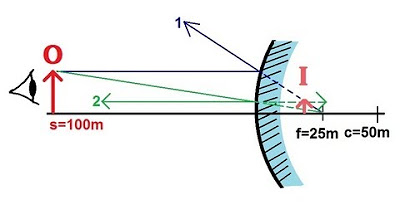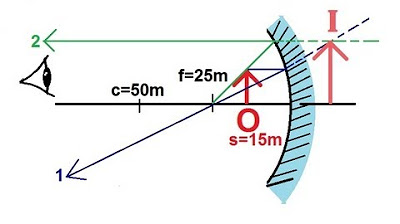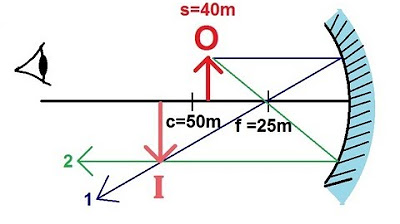Physics 51/54 - Optics: Mirrors (6 of 6) Flat Mirror
TLDRThis educational script explains the properties and behavior of flat mirrors, focusing on their unique characteristic of having an infinite focal length. It demonstrates how rays of light reflect off a flat mirror, resulting in a virtual image that appears to be the same distance behind the mirror as the object is in front. The script also illustrates the process of finding the image distance and magnification, revealing that the image formed by a flat mirror is upright and the same size as the object, thereby providing a clear understanding of the concept.
Takeaways
- 🔍 The focal length of a flat mirror is considered to be infinity, meaning the focal point is infinitely far away.
- 📐 To find the focal point of a concave mirror, shine light parallel to the normal, and the reflected rays will converge at a point, which is the focal point.
- 🔄 For a flat mirror, the reflected rays will go back in the direction they came from, never converging unless considered infinitely far away.
- 👀 The human brain perceives an image formed by a flat mirror where the reflected rays appear to diverge from, even though they do not actually converge.
- 🎯 The image formed by a flat mirror is virtual, meaning it appears to be behind the mirror and cannot be projected onto a screen.
- ✂️ The image distance (S') can be calculated using the formula S' = -SF/(S - F), with the focal length (F) being infinity for a flat mirror.
- 🔢 In the given example, the object is placed 50 cm away from the mirror, and the image distance is found to be -50 cm, indicating a virtual image behind the mirror.
- 🌐 The magnification (M) of a flat mirror is calculated as M = -S'/S, and in this case, it equals 1, meaning the image is the same size as the object.
- 📏 The magnification of 1 also indicates that the image is upright, as there is no inversion in size or orientation.
- 🤖 Understanding the properties of flat mirrors is essential for analyzing and solving problems related to reflection and image formation.
- 📚 The script provides a step-by-step explanation of how to work with flat mirrors, including determining image distance, magnification, and orientation.
Q & A
What is the focal length of a flat mirror?
-The focal length of a flat mirror is considered to be infinite, meaning the focal point is infinitely far away.
How does the focal point of a flat mirror differ from that of a concave mirror?
-In a concave mirror, parallel rays reflect back through a focal point, whereas in a flat mirror, the rays reflect back in the same direction they came from, implying the focal point is infinitely far away.
Why do we use the term 'infinity' for the focal length of a flat mirror?
-We use 'infinity' for the focal length of a flat mirror because the reflected rays do not converge at a finite point; they would only converge at an infinitely far distance.
How does the brain perceive the image formed by a flat mirror?
-The brain perceives the image by interpreting the reflected rays as if they came from a point behind the mirror where they appear to converge, creating a virtual image.
What type of image does a flat mirror produce?
-A flat mirror produces a virtual image, which appears to be behind the mirror rather than in front of it.
How can you determine the image distance for an object in front of a flat mirror?
-You can use the equation S' = -SF / (s - F), where S is the object distance, F is the focal length, and S' is the image distance. For a flat mirror, F is infinity, so the image distance is the same as the object distance but with a negative sign, placing it behind the mirror.
What is the magnification of an image formed by a flat mirror?
-The magnification of an image formed by a flat mirror is 1, meaning the image is the same size as the object.
Is the image formed by a flat mirror upright or inverted?
-The image formed by a flat mirror is upright, as the magnification is 1 and there is no flipping of the image vertically or horizontally.
What happens when you draw a ray from the object to the mirror at the point where the normal hits the mirror?
-According to the reflection laws of mirrors, the angle of incidence is equal to the angle of reflection, and the ray will be reflected in a direction that maintains this relationship.
How can you graphically find the image for an object in front of a flat mirror?
-You draw rays from the object to the mirror, reflecting them according to the law of reflection, and then use the brain's interpretation of where these rays appear to converge to locate the virtual image.
What is the significance of the negative sign in the image distance calculation for a flat mirror?
-The negative sign indicates that the image is virtual and located on the same side of the mirror as the object but behind the mirror's surface.
Outlines
🪞 Understanding Flat Mirrors and Their Image Formation
This paragraph explains the concept of flat mirrors, emphasizing that their focal length is considered infinite, meaning the focal point is infinitely far away. It illustrates the behavior of light rays reflecting off a flat mirror, showing that they return in the direction from which they came, never converging to form a real image. The explanation includes a practical method to determine the focal point using parallel light rays. The paragraph then graphically demonstrates how the human brain perceives a virtual image behind the mirror by interpreting the paths of reflected rays. It concludes with a mathematical approach to calculate the image distance for a flat mirror, which turns out to be the same as the object distance but on the opposite side of the mirror, indicating a virtual image. The magnification is also discussed, revealing that it remains the same as the object size, and the image is upright.
Mindmap
Keywords
💡Flat Mirror
💡Focal Length
💡Object Distance
💡Image Distance
💡Virtual Image
💡Magnification
💡Upright Image
💡Reflection Laws
💡Concave Mirror
💡Normal
💡Theta Subscript i
Highlights
Introduction to the example of a flat mirror and its properties.
Explanation of the focal length of a flat mirror being equal to infinity.
Demonstration of how rays reflect off a concave mirror to its focal point.
Description of the process to find the focal point of a mirror using parallel light rays.
Difference between a flat mirror and a concave mirror regarding focal points and convergence of rays.
Graphical method to find the image in a flat mirror using reflection laws.
Observation that the image formed by a flat mirror is virtual and appears behind the mirror.
Use of the equation S' = SF / (s - F) to calculate image distance in a flat mirror.
Simplification of the equation due to the focal length being infinity, leading to an image distance of -50 cm.
Confirmation that the image is virtual due to its position behind the mirror.
Calculation of magnification (M) using the formula M = -S' / s, resulting in a magnification of one.
Conclusion that the image size is the same as the object size due to the magnification of one.
Observation that the image is upright, indicated by a positive magnification value.
Summary of the properties of flat mirrors: virtual image, same size as the object, and upright orientation.
Explanation of how the brain perceives the convergence of rays to form a virtual image.
Final remarks on working with flat mirrors and understanding their optical behavior.
Transcripts
Browse More Related Video
5.0 / 5 (0 votes)
Thanks for rating:





